About 1821, a Brit – George Stephenson – successfully applied the burgeoning steam technologies of the Industrial Revolution to the field of transportation and created the world’s first steam locomotive. Over the next few years, he improved his design and sold a few English colliers on the benefits of shipping their product by rail. His invention precipitated the true birth of the railroad on 27 Sept 1825, when the first public passenger train, pulled by a Stephenson engine, ran from Darlington to Stockton, carrying 450 people at 15 miles (24 km) per hour.
The United States of America was just about 50 years old at the time. John Quincy Adams was president, elected by the House of Representatives when no candidate managed to garner a majority of votes in the Electoral College. There were 24 stars on the flag. Unhampered by the courts’ unprecedented affirmation of the rights of indigenous landholders and inspired by low prices guaranteed by the Land Act of 1820, droves of Americans were incessantly heading west to claim land in the Missouri and Northwest Territories. Military action to eradicate First Peoples from their ancestral homes was in full swing; the Kansa nation (as in “Kansas”) was forced to cede its entire domain, the government snagged a huge portion of Creek lands in Georgia by means of the Treaty of Indian Springs, and the Arikara War signaled the start of a campaign of devastating military actions against the native peoples of the Great Plains.
The nascent railroad industry took the expanding young country by storm. Train travel brought social, economic, and political changes that are almost too vast to comprehend.
Several railroad companies claim to be the first chartered in America,
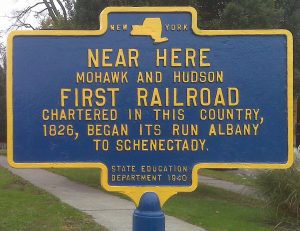
but the Baltimore and Ohio was the first major player on the scene. There were parades on the day construction began – July 4, 1828 – and the honor of turning over the first spadeful of earth went to 91-year-old Charles Carroll, the last surviving signer of the Declaration of Independence.
For generations, the magnificent spans, tunnels, stations and depots, the heroic steel-drivers and conductors, the infamous magnates and train robbers, the countless soldiers, performers, and hobos who rode the rails, the landmark achievement of the transcontinental railroad, the Golden Spike, and the trains themselves were the stuff of American lore, culture, and pride, immortalized in song and story. Railroad operations and operator vocabulary became part of everyday lingo. The nation that spans a continent from sea to shining sea was built by rail . . . which makes the current state of American train travel all the more pathetic.
We could have done our research beforehand, Roy and I. We could have “hit the rails” more well-informed. In addition to looking into the routes and tickets, Roy read up a bit on what our reservations entailed, but that was as far as it went. We were ready for an adventure, and so signed up for a marathon cross-country, multi-train journey with no real idea what it would be like or what to expect.
Our kindergarten was the Silver Star.
Devoted followers of this blog might be tempted to point out that, in fact, Roy and I already had 2 round-trip American rail journeys under our belts by the time we boarded the Star: the Princes of Princeton day-excursion and the ReUnion 2017 ride up and down the Hudson River Valley. Yes, true – but those journeys didn’t teach us much, because mass transit in and around NYC is unlike mass transit anywhere else in the US of A.
The Metropolitan Transit Authority (MTA) is the largest public transit authority in the United States, providing 2.73 billion trips each year to their customers. A few statistics for you:
- While nearly 85% of Americans rely on private automobiles to get them to work, 80% of New Yorkers take public transit
- 54% of households in New York City do not own a car, but rely exclusively on public transportation
- On an average workday, the MTA serves 15.3 million people in a 5,000-square-mile area from New York City through Long Island, south-eastern New York State, and Connecticut
- About 1/3 Americans using mass transit and 2/3 Americans travelling by rail are riding MTA subways, buses, and railroads (Long Island Rail Road, Metro-North Railroad, Staten Island Railway)
That’s just the iceberg’s proverbial tip. For more fascinating MTA stats and history, click HERE.
The MTA, New Jersey Transit, and Amtrak all share Penn Station (they’re fighting over rent and repairs even as I write this), while the MTA, NJ Transit, and PATH (Port Authority Trans-Hudson Corporation, a heavy rail rapid transit system linking Manhattan to NJ urban communities and suburban commuter rail) operate out of the famed Port Authority Bus Terminal. PATH alone adds another ½-million people to the public transit user tallies above.
Bottom line, NYC and environs have mass transport down. The trains in that corner of the country go everywhere you want to go, they are comfy enough, they run often, and they generally run on time.
Outside of that NY bubble, trains have limited routes to a finite number of places, they can be comfy or not comfy at all, they run anywhere from 3x a week (Sunset Limited) to several times an hour (Northeast Corridor/NY<–>DC), and only the commuter trains run on time. Usually.
The National Railroad Passenger Corporation, or AMTRAK (American Trak (track)), provides medium- and long-distance intercity service in the contiguous United States and parts of Canada – 46 states (nothing in Wyoming or South Dakota) and 3 provinces (British Columbia, Ontario, Québec). It serves more than 500 destinations and operates more than 300 trains each day over 21,300 miles (34,000 km) of track.
Sounds good . . . only many of those 500 destinations cannot be reached by rail, but require bus connections (which Amtrak provides through affiliates like Greyhound) and sometimes a hella-long bus ride. There are track sections, apparently, that allow trains to run up to 150 mph (240 km/h); none of the trains we rode ever approached this speed. And, no surprise, nearly 2/3 of Amtrak’s passengers are commuters living in the 10 largest metropolitan areas, while 83% of Amtrak passengers travel on routes shorter than 400 miles (644 km).
As for the on-time performance issue (OTP), Amtrak is highly aware. They recognize that arriving late can mean missing a connection or missing a meeting. They appreciate that funerals, weddings, graduations, and other important events will proceed with or without you. They realize a late train can lose you a contract, an interview, a job. They want to get you where you’re going on-time.
So, why can’t they? Amtrak explains it all for you HERE, and end their explanation with a plea for you to take your complaints to the Surface Transportation Board. They even provide a quick-link.
The nub of the problem is that 72% of the miles Amtrak travels are on freight railroad infrastructure. The way the freight companies see it, Amtrak trains run at their discretion, and they can damn well wait for the track to be clear. Amtrak took it to court and won; by law, passenger trains are supposed to receive priority, even when operating on freight railroad tracks. But they don’t. Freight tracks are controlled by freight dispatchers and employees. When Amtrak conductors receive a signal to side-line and wait for a freight train to go by, they have no choice but to pull over and wait – and that’s the signal they get every dang time.
Trains are also and often held for problems and potential problems on the line (mechanical, structural, or animal) or with the engine. Our longest delay was due to a dangerous practical joke. Somebody – full-of-themselves youngsters with not enough to occupy their time, is my guess – left a pick-up truck on the rails in the middle of Nowhere, California. That story in full in a future post.
Amtrak handles these inevitable delays with integrity. It does get a bit tiresome to hear the conductor apologizing for the train’s lateness the entire way down the line, but it is the right thing to do. Amtrak holds trains so people can make their connections. They de-train people and load them onto buses to get them to connections they would otherwise miss. Attendants take personal responsibility for making sure their charges get off and on the train at the appropriate stops. The attentive attitude extends to the Amtrak-related bus lines, as well. When a full bus-load of stressed-out Amtrak/Greyhound passengers were about to miss all their connections because the luggage inspector was taking his time getting to the dock, the Greyhound bus driver violated protocol, unlocked the baggage compartment, and handed out the bags. Hope he didn’t get in trouble . . . again, it was the right thing to do.
Until 1920, rail was the only practical means of inter-city travel. With the rise of the automobile and aviation, the railroads declined – not in a Darwinian “survival of the fittest” way, but because the government chose to subsidize the Interstate Highway System and Federal Aviation Administration over passenger rail. There was a brief resurgence of train travel during World War II; it didn’t last much beyond the V-J Day armistice. The railroads stayed economically viable for a couple more decades thank to contracts with the U.S. Postal Service. Almost all mail was transported on passenger trains until 1967, when the USPS switched its first class mail almost entirely to trucks, airplanes, and cheaper (and slower) freight trains.
Since then, Amtrak has continued to struggle for support from a government that heavily subsidizes the auto industry (bailing out GM, Chrysler, and Ford 8 years ago for about $12 billion, for example), the Interstate Highway System, the Federal Aviation Administration, many airports, and airport security. Amtrak covers its own security, shares in none of the tax breaks afforded airports for construction and maintenance, and pays property taxes from which highway users are exempt. Speaking to Reuters about subsidies in 2008, then President of Amtrak Alex Kummant observed, “It’s like $40 a passenger for Amtrak and $500 to $700 per automobile.”
Amtrak means well and tries really hard – and that counts for a lot. The company simply doesn’t have the clout or cachet to bring American train travel into the 21st century. Obama was the first President to even mention rail plans in a State of the Union address in decades, but the politics of the time dictated that anything he supported must be nixed. Passenger rail improvements in Florida, Ohio, and other states failed when newly-elected Republican governors spitefully halted existing high-speed rail plans and returned the federal funding for the projects. Currently the only high-speed construction under way is for the California High-Speed Rail that will link Los Angeles and San Francisco in under three hours.
The poor relation of the American transportation industry, Amtrak does its best to make up for a deficit of resources with a surfeit of cordial, personal service. When Roy was cementing our itinerary, it was a helpful rep at the other end of the phone line who steered us away from the Rail Pass and sold us more cost-effective individual-trip tickets at senior discount prices. When I thought I had accidentally deleted our entire itinerary from the Amtrak server, it was a helpful rep at Albany station who calmed my fears, and then, noticing that Roy was getting all the travel reward points, gave me detailed instructions on how to get myself onto the rewards program and earn my own credit for our miles. Throughout our travels, everybody working for Amtrak did their absolute best to ensure that each and every passenger had a safe, pleasant journey, and that they reached their various destinations as close to the scheduled arrival time as possible.
Though their absolute best was not always sufficient to keep inconvenience at bay, on our kindergarten excursion from New York to Tampa, it was more than ample.
We arrived at Penn Station, as usual, via the Q-train from Brooklyn and with bags in hand. A little anxious, we arrived pretty early; our train wasn’t even listed on the board yet. We grabbed some tea/coffee and some breakfast yummies, and chowed down in the Amtrak lounge. Wasn’t long before we heard the boarding call for #91 – the Silver Star; we gathered our stuff and headed for the gate.
A long line had already formed. No problem. The line was for coach. First lesson: passengers who have reserved sleepers, even mini-sleepers (roomettes), get special treatment. Priority boarding is standard.
We were directed to the proper car where Josh pointed us to our compartment. Every Amtrak car has its own attendant. At the time, I thought Josh was extra solicitous because we were Amtrak newbies. Now I think it was just his nature. Virtually all the attendants on all the trains we took were super kind and conscientious.
Roy took one glance at the teeny-tiny roomette and shook his head, dismayed.
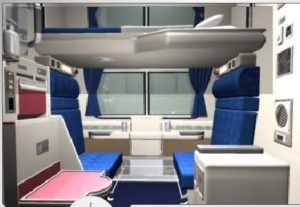
He was sure we would never be able to fit ourselves, our 2 big suitcases, our 2 small packs, and my shoulder bag into the cramped space. To my eye, it looked totally do-able. The pic has the upper bunk in the down/bedtime position. For daytime use it slides up the wall and rests well above the seats, leaving plenty of headroom. At night, the two seats slide toward each other to form a bunk, the upper bunk slides down. Both passengers get their own lights and climate control, and also their own window for watching the world roll by. Check out the upper bunk “cargo” net.
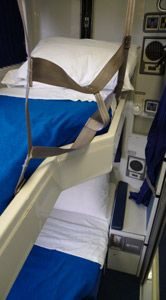
So, suitcases could go on the upper bunk until bedtime, then one could sit on the toilet seat and the other maybe slide under the lower bunk. There were pull-down hooks, and a narrow ledge where items could be secured by means of a strong strap (look on the far right of the pic).
Yes, ok, it would take some clever juggling – but this was going to work.
And it did, though we did take another lesson from it. Before boarding our next train, we would re-pack all our over-night stuff into one bag. No need to be constantly swapping out one for the other, when there was barely room for either.
By the time we were zipping by Washington, D.C.,
we were nicely settled into our adjustable chairs, enjoying the leg-room and privacy of our compartment, Roy was reading, and I had my pad out. No internet on this train (argh), but nothing to stop me writing on the little pull down table between us.
The Silver Star is a Viewliner. This is the sleeper car (the higher row of windows are where the upper bunks sit); that’s a coach car behind it.
It’s not the newest train on the rails, but as with the older aircraft we had taken from Santa Rosa to Los Angeles, the more antiquated model boasted some comforts that we later missed when riding the more modern Superliners.
The Viewliner roomettes could have been the inspiration for Corbin Dallas’ apartment in The Fifth Element or today’s micro-apartment designs. On the left you see the toilet (nicely covered with a heavy wooden lid that doubles as the first step up to the top bunk), and above it the pull-down sink (with a ledge that is the second step for climbing into the upper bunk).
Here’s the sink down.
Here it’s back up, and there’s the mirror, towels/washcloths, paper cups . . . I found the fold-up/fold-down organization of the space delightful.
Other side of the cabin, below the ledge with the strap, was this tidy compartment with TP and a trash bin.
The Viewliner roomette was tiny – “emphasis on the ‘ette,’” as my husband is fond of saying – but it was a tiny room. It had what we needed to get through the night. At one end of each sleeper and coach car were airplane-style restrooms, and the sleepers had shower rooms as well. Peering into the larger, way-more-expensive sleepers, we saw each had a couch that opened to a 2-person (2 skinny person) bed, plus an overhead bunk, a real sink, and a private bathroom behind a real door. Yes, very posh, but while we used the public head for day-time business, our roomette’s little cupboard toilet was brilliant for a late-night whizz. No dining car on the Viewliner, but there was a snack bar and a little dining area/observation room, if you wanted company or a broader view. And each sleeper had a little comfort zone at the end of the car that attendants kept stocked with hot coffee, bottled waters, and OJ.
Lesson #3 in our Riding the Rails Primer: relax and enjoy the ride.

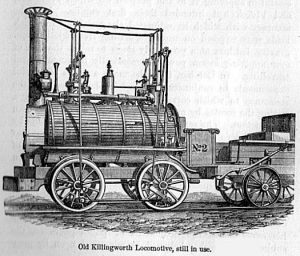
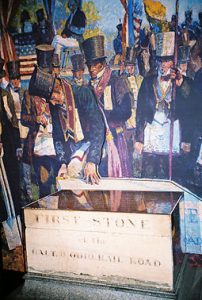
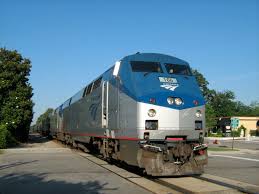
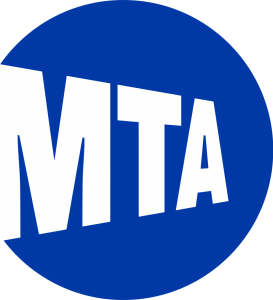
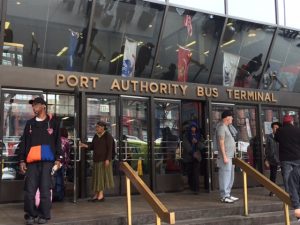
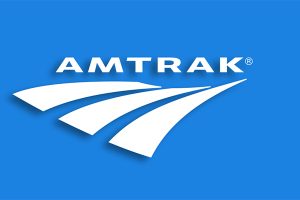
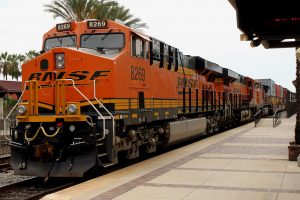
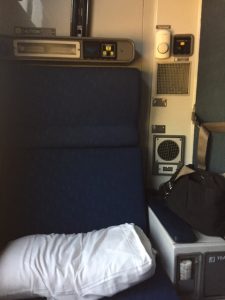

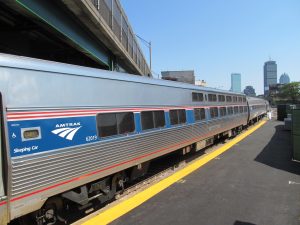
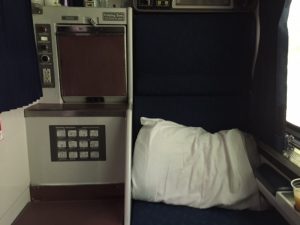
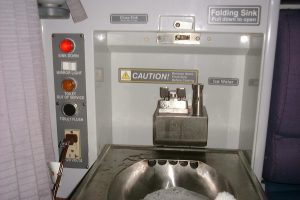
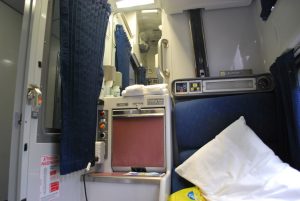
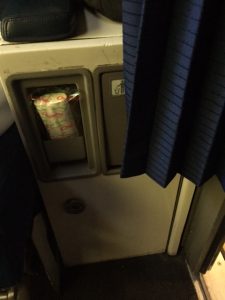

First of all, Charles Carroll is a distant ancestor cousin of mine. My Uncle Carroll was named after him. Secondly, in my day, Port Authority Terminal was more infamed than famed. Glad to hear it’s cleaned up its act. (The photo looked quite classy, actually.)
The roomette reminded me of the VW camper my parents used to pack all seven of us in to go car-camping. Five kids arguing over who got to sit at the table and play poker while mom or dad drove (off the deep end.) At least you had the luxury of a potty! Loving these blogs!
Wait, what?!? Wow, 6-degrees and all that. I had no idea you had a distant ancestor signatory of the Dec of Independence. (What great timing, finding this out.)
Port Authority is still a madhouse, and not exactly pristine — but it’s all lined with shops everywhere now, and discount ones, really an interesting ambiance. A side tidbit I love about Port Authority is that the athletic shop franchise “Sports Authority” is oh-so clearly a NYC in-joke . . . that goes completely over the heads of everyone else in the country.
Yes, the Viewliner was my fave of the bunch. You’ll see . . . thanks for reading!!
Trust you to sneak in a reference to the excellent ‘Fifth Element’.
Sounds like fun, the whole trip, even if you need a degree in human origami in order to travel. On the plus side, you were inside the train, and not on the roof (India), or eating food that is inedible whilst stationery before a pile of leaves (UK), and you didn’t have to sell your house to buy a ticket (Ireland).
No need to comment on the empire-building of the Brits (they sure caused trouble around the world), nor will I say much about the native peoples of America and their fate, lest I upset some of your readers…
Enjoy the ride.
Credit where credit’s due — it was actually Roy who make the correlation between Fifth Element and the roomettes. And yes, true enough, our journey was quite luxurious compared to train travel in some other areas of the world. Still, if my blog has not yet had the effect of discouraging my Euro-friends from seeing the USA by rail (that’s assuming America loses its present forbidding demeanor and becomes a welcoming nation again), just wait. The Silver Star was the best of the lot; tales of the Capitol Limited, Southwest Chief, California Zephyr, Coast Starlight, and Capitol Corridor are yet to come.
With travelogue in between . . . ah, well. ;)